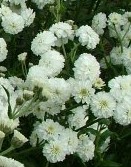 A native of Europe and western Asia, sneezewort is a rhizomaceous perennial that spreads and naturalizes if the soil is good. It is a membet of the aster family, Asteraceae, that also includes daisy, sunflower, and lettuce. The dark green leaves are finely toothed, linear to lance-shaped, and lack a petiole. The small white flowers are borne in loose clusters from during the summer. Although the species is not a desirable garden plant there are several good cultivars available that vary in the color and fullness of the flowers, height, and bloom time. Even plants that have double flowers, however, can produce up to thirty percent single flowers depending on the variety and climatic conditions. Cultivars are useful in borders, natural areas, and cutting gardens. Double flowered cultivars dry well. The flowers are said to cause sneezing and the dried roots and leaves have been used as an inexpensive substitute for snuff hence the common name, sneezewort. The genus name, Achillea, honors the Achilles, the Trojan War hero that is said to have used a plant of this genus to treat the wounds of his soldiers. The specific epithet, ptarmica, is from the Greek word ptarmike referring to a plant that causes sneezing.
A native of Europe and western Asia, sneezewort is a rhizomaceous perennial that spreads and naturalizes if the soil is good. It is a membet of the aster family, Asteraceae, that also includes daisy, sunflower, and lettuce. The dark green leaves are finely toothed, linear to lance-shaped, and lack a petiole. The small white flowers are borne in loose clusters from during the summer. Although the species is not a desirable garden plant there are several good cultivars available that vary in the color and fullness of the flowers, height, and bloom time. Even plants that have double flowers, however, can produce up to thirty percent single flowers depending on the variety and climatic conditions. Cultivars are useful in borders, natural areas, and cutting gardens. Double flowered cultivars dry well. The flowers are said to cause sneezing and the dried roots and leaves have been used as an inexpensive substitute for snuff hence the common name, sneezewort. The genus name, Achillea, honors the Achilles, the Trojan War hero that is said to have used a plant of this genus to treat the wounds of his soldiers. The specific epithet, ptarmica, is from the Greek word ptarmike referring to a plant that causes sneezing.
Type: Herbaceous perennial
Bloom: Clusters of small white, double or single flowers are produced for long bloom time in summer.
Size: 1-2’ H x 1’ W
Light: Full sun
Soil: Average, moist, well-drained
Hardiness: Zones 3-9
Care: Low maintenance
Pests and Diseases: Susceptible to rots, rust, and powdery mildew especially if grown in poorly drained soil.
Propagation: Seed, division
Companion plants: Coneflower, daylily, ornamental grasses, Salvia ‘May Night’
Outstanding Selections:
-
- ‘Gypsy White’ (double flowers, compact plants 14” tall)
- ‘Stephanie Cohen’ (pink flowers, 12” tall)
